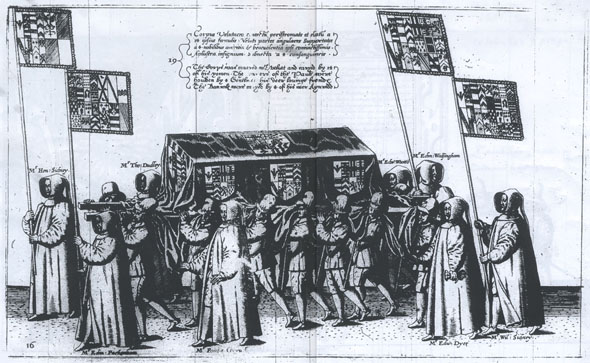
A London Provisioner's Day Book, 1550-1563
For comments and inquiries concerning the Day Book project please contact Professor Richard W. Bailey.
For comments and inquiries concerning this demonstration page please contact Elon Lang.
This Day Book was one of the treasures of the library of the antiquarian Robert Cotton, and it was stored in the same bookcase with the Beowulf manuscript. In the terrible fire that did so much damage to this library in the early eighteenth century, the 162 leaves of the diary were badly damaged and portions of the outside margins and the top of the text were charred or burned away. Fortunately extensive selections were published by the historian John Strype who used the manuscript before the fire, and it is possible to supply many missing portions by consulting his historical works.
The burned pages of the diary were jumbled in a box until the early nineteenth century when one of the librarians at the British Museum had them mounted on framing pieces of paper and sorted into order. In 1848, an antiquarian produced an edition, but even a century ago scholars pointed to its errors and questioned its value for scholarship. Nothing was done, however, to remedy these problems - until now.
This web-page is designed to demonstrate a preliminary version of the interface for our online edition of the Day Book. Our goal is to electronically recreate the format and language of the original manuscript that was not conveyed in the sole published edition in 1848.
The foundation of this electronic edition is a transcript of the original manuscript compiled from images of the actual folio pages by Anne Curzan, Sylvia Giminez, Kenneth Hodges, Colette Moore, Joy Ochs, and Patricia Rice, under the direction of Professor Bailey. To fill in the gaps in the original text caused by fire damage, Elon Lang, working with Colette Moore and Professor Bailey, has inserted text from the histories published by Strype. In many cases, entries in the diary are not found in Strype's works and missing text has had to be supplied by referring to the 1848 edition (where J. G. Nichols's intelligent guesses are recorded) and using our own judgement. We are very careful, however, to distinguish between the original text from the manuscript and our enhancements. All enhancements are displayed in a different font color and the reader may select an option at the top of each page to view the folio transcript without the enhancements. All enhancements taken from Strype can be clicked to display a citation to the specific volume, chapter, and page number from which material has been taken, in a pop-up window. All enhancements from material generated elsewhere are enclosed in square brackets. In all cases, the location of missing text is indicated by a "#" sign.
The example folio pages presented in this demonstration show most of the basic features that we are planning for our edition. These include:
Other forthcoming features may also include:
The search engine we intend to develop for this work will allow the reader to index the entire transcript with or without the enhancements. It will enable the reader to quickly search the Day Book for specific dates and subject-keywords for historical study, as well as search for words in the author's dialect by their Modern English equivalents - an excellent resource for linguistic research.
This index will allow readers to use the Day Book to answer a great many questions. For example:
Eventually, pending final arrangements with the American Council of Learned Societies, we plan to integrate this fantastic tome of eye-witnessed practical and cultural history into the History E-book Project, which would make the diary available and searchable along with a long list of important works of history to scholars and interested readers around the world.
Thank you for your interest in the Day Book. Please click here to enjoy this demonstration.
Demonstration page design and text enhancements by Elon Lang under the direction of Professor Richard W. Bailey,
with programming assistance from Brian Rosenblum, the facilities of the Scholarly Publishing Office at the University of Michigan Digital Library,
and the support of the Department of English Language and Literature at the University of Michigan.